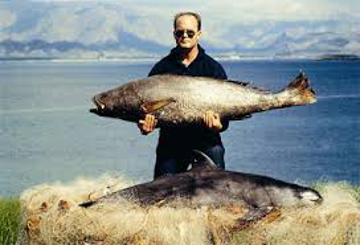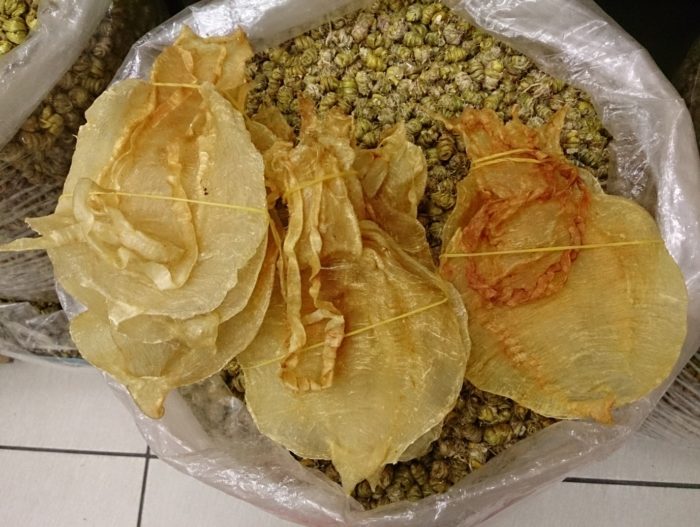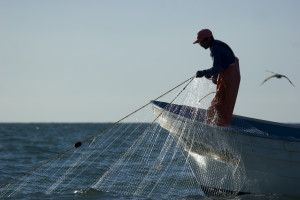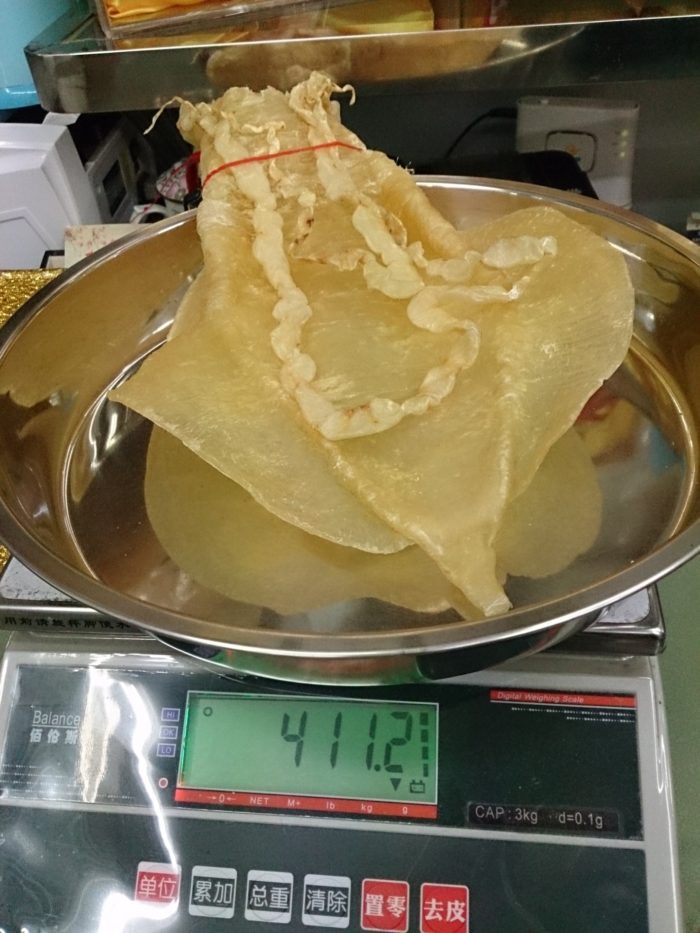Illegal fish trade pushes critically endangered vaquita to extinction



中文翻译请见下方
A recent survey by the Environmental Investigation Agency (EIA) of marine product sellers in southern China and Hong Kong revealed a continuing illegal trade in a banned fish species which, if left unchecked, will lead to the extinction of the vaquita – the world’s most endangered marine mammal.
The vaquita is a small porpoise found only in the waters of the northern Gulf of California, off the coast of Mexico. In 1997, its population was estimated at 567 but by 2014 it had plummeted to just 97 animals due to fishery bycatch.

Vaquita and totoaba (c) NOAA Fisheries
Evidence based on acoustic surveys suggests a 42 per cent decline in the vaquita population in 2013-14. This alarming drop is due to the resurgence of illegal gillnet fishing targeting totoaba fish, the swim bladders of which are highly sought in Hong Kong and southern mainland China.
International trade in totoaba fish has been banned under a global convention since 1977, yet black market trade persists. Its dried swim bladder, known as fish maw, is used in foods such as soups for its supposed health benefits. There are around 34 different types of fish maw but totoaba is one of the most highly prized and expensive and is referred to as “golden coin” maw in the trade.
In May 2015, EIA conducted a survey of 23 fish maw retailers in Hong Kong and Guangzhou, China, as well as online research to ascertain the availability of illegal totoaba products on the market. The results show that illegal trade continues to supply a relatively small group of entrenched consumers, indicating a failure by enforcement agencies to curb the smuggling and sale.
In Guangzhou, EIA found “golden coin” maw openly on sale in seven of the 12 shops surveyed. Generally, traders were aware that totoaba sales are illegal, knew the fish are only found in Mexico and claimed that smuggling the contraband between Hong Kong and mainland China is easy with customs agencies not routinely inspecting fish maw consignments.

Totoaba maws openly on sale in Guangzhou, China (c) EIA
Hong Kong traders were more guarded, with only two shops displaying totoaba maw, but prices were found to be higher than on the mainland. Despite this, the main buyers were found to be mainland Chinese due to the perceived higher quality of supplies from Hong Kong and the higher possibility of fakes in Guangzhou.
Online research conducted by EIA identified numerous platforms for trade in fish maw, with significant interest in totoaba maw among consumers. Some of these platforms were actively offering fish maw, including totoaba, for sale. A sense of the global nature of the trade was provided by analysis of Facebook pages connecting fish maw traders and buyers from South America, Mexico, the US and Asia.

Gillnet fishing (c) Chris Johnson
EIA’s survey also uncovered a fall in the market price for totoaba maw since 2012 due to a spike in illegal trade causing oversupply in the market. While totoaba prices remain high compared with other fish maws, the decline of as much as 75 per cent from the record prices of a few years ago has led to stockpiling by traders hoping to push the price back up. One trader also spoke of a core group of “loyal” totoaba consumers who use the maw on a daily basis and were using the price drop to stock up.
The plight of the vaquita has recently gained international attention. Mexico has implemented an emergency two-year gillnet fishing ban throughout the vaquita range. US agencies in southern California, which is a hub for totoaba maws smuggled from neighbouring Mexico en route to China, have made a series of seizures and prosecutions.

Prices for totoaba maws depend on a number of criteria including size, sex, weight and age. This 6-9 year old maw was being sold for 80,000 RMB (approximately £8,250); the same trader had hundreds of younger totoaba maws selling for 1/10th of the price (c) EIA
However, as EIA’s survey shows, the enforcement response in the main markets of Hong Kong and China remains inadequate.
Clare Perry, Team Leader of EIA’s Oceans Campaign, said: “The future survival of the vaquita rests in the hands of a relatively small number of Chinese consumers of totoaba maw. While this lucrative market continues, vaquita will inevitably die in illegal fishing nets and dwindle to extinction.
“Customs and other enforcement agencies in China need to step up their efforts to halt the illegal totoaba trade.”
EIA is calling for online retail platforms in China to stop selling totoaba maw, for increased surveillance of marine products markets in Hong Kong and Guangzhou and for customs agencies to prioritise interception of contraband fish maw.
The only recorded case of a cetacean (whale, dolphin or porpoise) species becoming extinct is the baiji or Chinese river dolphin; found only in China’s Yangtze River, the species was declared functionally extinct in 2006.
China now has a vital role to play in ensuring that the vaquita does not go the same way.
环境调查署(EIA)最近在内地南方与香港的海产市场的调查结果显示,非法花胶的贸易仍然猖獗,若继续不加管制,海湾鼠海豚(也称小头鼠海豚、加湾鼠海豚,拉丁名:Phocoena sinus)——世界上最濒危的海洋哺乳类动物——将因此灭绝。
海湾鼠海豚是一种仅生活在靠近墨西哥的加利福尼亚北部湾水域内的小型海豚。由于对生活在同一海域内的加湾石首鱼(拉丁名:Totoaba macdonaldi)的捕鱼作业常常误捕海湾鼠海豚,它的数量由1997年约567尾急跌至2014年的97尾。

海湾鼠海豚和加湾石首鱼©NOAA 渔业协会
声源调查发现在2013-2014年间,海湾鼠海豚的数量就下降了42%。如此巨大的跌幅是由于香港和内地南方地区对加湾石首鱼鱼鳔的大量需求,以致非法用刺网捕捉加湾石首鱼的问题再度严重化。
1997年颁布的全球公约禁止了加湾石首鱼国际贸易,但其黑市交易却屡禁不止。鱼鳔的干制品俗称“花胶”,常因其所谓的健康疗效用于制作汤类等菜肴。在34种不同的花胶中,加湾石首鱼花胶以其高昂的身价拔得头筹,黑市常称“金钱鳘”。
为了解非法加湾石首鱼产品在市场上的分布,EIA于2015年5月实地走访了香港和广州的23家花胶零售商并且进行了网络调查。调查结果显示,非法加湾石首鱼花胶持续供应一批数量相对较小却忠实的顾客,这也证实了执法部门未能有效遏制走私和非法贩卖的情况。

中国广州市场上公开销售的石首鱼花胶 ©EIA
EIA在广州走访了12家商铺,其中7家公开销售“金钱鳘”。这些商贩通常了解贩卖加湾石首鱼花胶是违法行为,并且这种鱼类仅生活在墨西哥地区。他们称海关并不经常检查花胶类干货, 所以将此类违禁品从香港走私至中国大陆十分简单。
香港的商贩则更为谨慎,仅有两家商铺公开陈列加湾石首鱼花胶,但是价格却比中国大陆高出许多。尽管价格高昂,来自中国大陆的买家却占了大多数,因为香港的花胶通常被认为质量更佳,而广州的很有可能是赝品。
EIA 的网络调查发现了众多花胶交易平台,发现消费者对加湾石首鱼花胶情有独钟。一些平台上的交易十分活跃,提供出售加湾石首鱼花胶和其他各类花胶。通过对Facebook群组里来自南美洲、墨西哥、美国和亚洲的买卖方的分析,我们发现花胶贸易是全球性的。

刺网捕鱼© Chris Johnson
EIA的调查还发现,由于非法交易激增,黑市上的加湾石首鱼花胶供大于求,自2012年起其市场价格略有下降。尽管加湾石首鱼花胶比起同类商品仍处在价格高位,但和几年前的记录相比已经下降了多达75%,所以商贩希望通过囤积库存重新把价格拉高。一名商贩透露,几位每日消费石首鱼花胶的“忠实”老买家正在低价囤货。
最近海湾鼠海豚的困境受到了国际关注。墨西哥在海湾鼠海豚的分布海域实施了一项为期两年针对刺网捕鱼的紧急禁令。美国的执法机构在南加利福尼亚地区,即加湾石首鱼花胶从墨西哥海案走私至中国的多发地,查获了多起案件,收缴了大量走私花胶。

加湾石首鱼花胶的价格取决于多种标准,包括大小,性别,重量和年龄。这条6-9岁的加湾石首鱼的花胶以80, 000元成交。该商贩持有上百条幼龄的石首鱼花胶,只能以该价格的十分之一成交。©EIA
尽管如此,EIA的调查显示香港和内地的执法行动仍然缺乏力度。
EIA海洋项目负责人Clare Perry表示:“海湾鼠海豚的未来生存状况取决于少数加湾石首鱼花胶的华人买家。若这个暴利市场持续发展,海湾鼠海豚将无可避免地死在这些非法渔网中,逐步减少直至灭绝。”
“中国海关和其他执法机构急需加强针对非法加湾石首鱼交易的执法。”
EIA呼吁中国线上交易平台停止出售加湾石首鱼花胶,呼吁执法机构对香港和广州的海产品市场增强管制,并且呼吁海关优先查验违禁花胶产品。
仅生活在中国长江白鳍豚,于2006年被宣告“功能性灭绝”。这是自上世纪50年代以来唯一一种灭绝的鲸类。
现 在为确保加湾鼠海豚不重蹈白鳍豚的覆辙,中国任重道远。